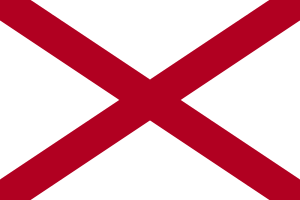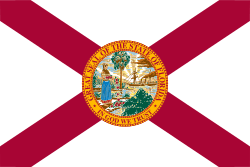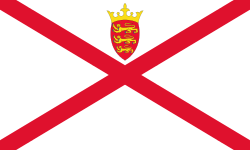Saint Patrick's Saltire
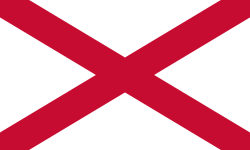
Saint Patrick's Saltire or Saint Patrick's Cross is a red saltire (X-shaped cross) on a white field, used to represent the island of Ireland or Saint Patrick, the patron saint of Ireland. In heraldic language, it may be blazoned Argent, a saltire gules. Saint Patrick's Flag is a flag composed of Saint Patrick's Saltire.
The red saltire's association with Saint Patrick dates from the 1780s, when the Order of Saint Patrick adopted it as an emblem. This was a British chivalric order established in 1783 by George III. There is some evidence that a similar saltire was occasionally used to represent Ireland before this. It is often suggested that it derives from the arms of the powerful Geraldine or FitzGerald dynasty.[1][2] Most Irish nationalists reject its use to represent Ireland as a "British invention".[1]
After its adoption by the Order of Saint Patrick, it began to be used by other institutions. When the 1800 Act of Union joined the Kingdom of Ireland with the Kingdom of Great Britain, the saltire was added to the British flag to form the Union Flag still used by the United Kingdom. The saltire has occasionally served unofficially to represent Northern Ireland and been considered less contentious than other flags flown there.

Origins
The origins of Saint Patrick's saltire are unclear. The first recorded mention of a Saint Patrick's flag is from the journal of John Glanville, writing about the Anglo-Dutch fleet that sailed to Cadiz, Spain, in 1625. In it Glanville remarks: "That this was an Englishe and not an Irishe action, and the colours contended for the fflagg of St George and not of St Patericke, which hee intimated to himselfe being a Baron of England much auntient to my Lord Cromwell (whoe alsoe is a Baron of that Realme) to bee more proper and worthie to carry then anie Irish Viscount whatsoever."[3]
The Order of Saint Patrick, an Anglo-Irish chivalric order, was created in 1783. The order was a means of rewarding those in high office who supported the Anglo-Irish government of Ireland.[4] On its badge was a red saltire on a white background, which it called the "Cross of St Patrick":
And the said Badge shall be of Gold surrounded with a Wreath of Shamrock or Trefoil, within which shall be a Circle of Gold, containing the Motto of our said Order in Letters of Gold Viz. QUIS SEPARABIT? together with the date 1783, being the year in which our said Order was founded, and encircling the Cross of St Patrick Gules, surmounted with a Trefoil Vert each of its leaves charged with an Imperial Crown Or upon a field of Argent.
The use of a saltire in association with St Patrick was controversial because it differed from the usual crosses by custom worn on St Patrick's Day. In particular, the previous crosses associated with Saint Patrick were not X-shaped. Some contemporary responses to the badge of the order complained that an X-shaped cross was the Cross of St Andrew, patron of Scotland. A February 1783 newspaper complained that "the breasts of Irishmen were to be decorated by the bloody Cross of St Andrew, and not that of the tutelar Saint of their natural isle".[5] Another article claimed that "the Cross of St Andrew the Scotch saint is to honour the Irish order of St Patrick, by being inserted within the star of the order [...] a manifest insult to common sense and to national propriety".[5]
An open letter to Lord Temple, to whom the design of the Order of St Patrick's badges were entrusted, echoes this and elaborates:[5]
The Cross generally used on St Patrick's day, by Irishmen, is the Cross pattée, which is small in the centre, and so goes on widening to the ends, which are very broad; this is not recorded as the Irish Cross, but has custom for time immemorial for its support, which is generally allowed as sufficient authority for any similar institution... As bearing the arms of another person is reckoned very disgraceful by the laws of honour, how much more so is it, in an order which ought to carry honour to the highest pitch, to take a cross for its emblem, which has been acknowledged for many ages as the property of an order in another country? If the cross generally worn as the emblem of the Saint who is ascribed to Ireland is not agreeable to your Excellency, sure many others are left to choose from, without throwing Ireland into so ignominious a point of view, as to adopt the one that Scotland has so long a claim to.

Many subsequent commentators have believed that the saltire was simply taken from the arms of the FitzGeralds (or 'Geraldines'), who were Dukes of Leinster.[1] The Dukes of Leinster dominated the political and social scene of 18th century Dublin, from their ducal palace of Leinster House (later to become the seat of the Irish parliament and senate, the Oireachtas).[6] William FitzGerald, 2nd Duke of Leinster was the premier peer in the Irish House of Lords and a founder member of the Order of Saint Patrick. On the other hand, Michael Casey suggests that Lord Temple, pressed for time, had based the Order's insignia on those of the Order of the Garter, and simply rotated its St George's Cross 45 degrees.[7]
Earlier use of saltires in an Irish context
A variety of sources show saltires in use earlier than 1783 in Ireland and in an Irish context, although there is no suggestion that they are linked to St Patrick. It is often stated that they derive from the arms of the powerful FitzGerald dynasty (or 'Geraldines'), who were Earls of Kildare (and later Dukes of Leinster), although again there is no direct proof of this.[8] Gearóid Mór FitzGerald and his son Gearóid Óg, were also Lord Deputies of Ireland in the late 15th and early 16th centuries.
The design on the reverse of some Irish coins (groat and half-groat) minted c.1480 includes two shields with saltires. At this time, Gearóid Mór FitzGerald was Lord Deputy of Ireland, and the shields are considered to be his arms.[9][10]
A 1576 map of Ireland (or "Hirlandia") by John Goghe shows the FitzGerald arms over their spheres of influence. It also shows a red saltire flag flying at the masthead of a ship, possibly an Irish pirate, which is engaged in action in the St George's Channel with another ship flying the St George's cross. The red saltire flag does not appear upon Ireland itself, though it is placed upon the neighbouring Mulls of Galloway and Kintyre in Scotland.[2]

English and German picture maps of the battle of Kinsale of 1601/2 show the combined Irish–Spanish forces under a red saltire. This is presumed to be the Cross of Burgundy, the war flag of Spain, rather than an Irish flag.[11]

The cross of Burgundy appears on the flag of the Spanish Regiment of Hibernia. It was formed in 1710 from some of the many Irishmen who fled their own country in the wake of the Flight of the Earls and the penal laws. It is possible that the design of the flag was influenced by the red saltire.
A 1612 seal of Trinity College, Dublin shows uncoloured cross and saltire flags.[12] These have been taken to represent England and Ireland respectively.[13][14]
Contemporary reports of the ensigns of the Irish Catholic Confederation during the Eleven Years' War say that each had a canton with a red saltire on a gold field.[15][16][17] A 1645 picture map of the Siege of Duncannon shows Preston's Irish Confederates under a saltire.[14][18]
The flag used by the King's Own Regiment in the Kingdom of Ireland, established in 1653, was a red saltire on a "taffey" yellow field. Its origin remains a mystery, however.[19] At the funeral of Oliver Cromwell in 1658, Ireland was represented by a red cross (not saltire) on a yellow field.[2] A 1915 book about flags claims that Cromwell's Protectorate of the 1650s briefly used a flag containing the St George's cross to represent England, St Andrew's cross to represent Scotland, and a red saltire on white to represent Ireland.[20] Several drawings of Union flags, including one of HMS Henry made c.1661 by Willem van de Velde, the elder, include a red saltire as in the post-1800 Union; but there is no official evidence for such a design.[21] The Graydon MS. Flag Book of 1686, which belonged to Samuel Pepys, gives the flag of Ireland as the harp and St George's cross on a green field.[2]
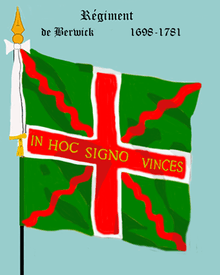
A red saltire on green appears on the flag of Berwick's regiment in the Irish Brigade of the French army. This was a brigade made up of Irish Jacobite exiles that formed in 1690. The Irish Brigade served as part of the French Army until 1792.

Several atlases and flag books in the late 17th and 18th centuries show a red-saltire–on–white flag for Ireland; including Paulus van der Dussen's (c.1690),[22] and Le Neptune françois, a marine atlas published in Amsterdam in 1693, where it is depicted with the legends Ierse above and Irlandois below — Dutch and French for "Irish".[23] Jan Blaeu's 1650s atlas has a saltire on white for Ireland, which is hand-coloured red in some copies.[24]
According to a newspaper report from Waterford in 1785, two years after the Order of St Patrick had been founded:[25]
Upwards of forty vessels are now in our harbour, victualling for Newfoundland, of which number thirteen are of our own nation, who wear the St Patrick's flag (the field of which is white, with a St Patrick's cross, and an harp in one quarter.)
St Patrick's Day crosses
There was once a widespread custom of wearing crosses on Saint Patrick's Day in honour of the saint, though these crosses were generally not saltires. There is evidence of the custom from the 17th to the early 20th century, which usually involved wearing a cross as a badge made of green or red paper or ribbon. Surviving examples of such badges show that they came in various colours[18] and they were mostly worn upright rather than as saltires.[5] Some examples also have an upright cross accompanied by a saltire of a different colour.
The second part of Richard Johnson's Seven Champions of Christendom (1608) concludes its fanciful account of St Patrick with, "the Irishmen as well in England as in that Country, do as yet in Honour of his Name, keep one day in the Year Festival, wearing upon their Hats each of them a Cross of red Silk, in Token of his many Adventures, under the Christian Cross".[26] Irish soldiers stationed in Britain in 1628 reportedly wore red crosses on St Patrick's Day "after their country manner".[18]
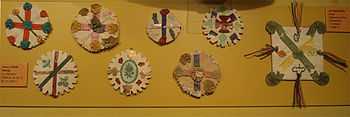
Thomas Dinely, an English traveller in Ireland in 1681, wrote that the Irish wore crosses in their hats, "some of pins, some of green ribbon".[27] Jonathan Swift, writing of St Patrick's Day 1713, said "the Mall was so full of crosses that I thought all the world was Irish".[28] In the 1740s, the badges pinned were multicoloured interlaced fabric.[29]
The crosses were also associated with Irish regiments, who were reported in 1682 to have been seen wearing crosses of red ribbon on St Patrick's Day; and with the English court, who were said to have worn crosses in honour of St Patrick on the saint's day in 1726.[30]
By the 1820s, the crosses were only worn by children, with simple multicoloured daisy patterns.[29][31] In the 1890s, they were almost extinct, and a simple green Greek cross inscribed in a circle of paper.[32] The Irish Times in 1935 reported they were still sold in poorer parts of Dublin, but fewer than those of previous years "some in velvet or embroidered silk or poplin, with the gold paper cross entwined with shamrocks and ribbons".[33]
Cross pattée
The cross pattée has long been associated with St Patrick, for reasons that are uncertain. One possible reason is that "pattée" shares its first syllable with "Patrick," making the use of the cross a visual pun. Another possibility is that bishops' mitres in Ecclesiastical heraldry often appear surmounted by a cross pattée.[34][35] An example of this can be seen on the old crest of the Brothers of St Patrick.[36] As St Patrick was the founding bishop of the Irish church, the symbol may have become associated with him. St Patrick is traditionally portrayed in the vestments of a bishop, and his mitre and garments are often decorated with a cross pattée.[37][38][39] [40] [41]
The cross pattée retains its link to St Patrick to the present day. For example, it appears on the coat of arms of both the Roman Catholic Archdiocese of Armagh[42] and the Church of Ireland Archdiocese of Armagh.[43] This is on account of St Patrick being regarded as the first bishop of the Diocese of Armagh. It is also used by Down District Council which has its headquarters in Downpatrick, the reputed burial place at St Patrick.
Modern use of the flag
.svg.png)
.svg.png)
The most widespread use of St Patrick's Saltire today is in the Flag of the United Kingdom. With the 1800 Act of Union that merged the kingdoms of Great Britain and Ireland, the red saltire was incorporated into the Flag of the United Kingdom as representing Ireland. The red saltire is counterchanged with the saltire of St Andrew, such that the white always follows the red clockwise. The arrangement accounts for the discontinuous look of the red diagonal lines, and has introduced a requirement to display the flag "the right way up", with the white line of St Andrew above the red of St Patrick in the upper lefthand quarter next to the flagpole.[44] As with the red cross, so too the red saltire is separated by a white fimbriation from the blue field. This fimbriation is repeated for symmetry on the white portion of the saltire, which thereby appears wider than the red portion. The fimbriation of the cross of St George separates its red from the red of the saltire.
Flags in Northern Ireland are controversial, their symbolism reflecting underlying sectarian and political differences.[45] Saint Patrick's Saltire is sometimes used as a cross-community symbol with less political baggage than either the Union Flag or the Ulster Banner, seen as pro-Unionist, or the Irish tricolour used by Irish nationalists.[46] It is one of two flags authorised to be flown on church grounds by the Church of Ireland, the other being the Compass Rose Flag of the Anglican Communion.[47] This was the recommendation of a 1999 synod committee on sectarianism.[47] For similar motives, it is the basis of the police badge of the new Police Service of Northern Ireland.[46]
It is one of the flags approved by the Orange Institution for display during Orange walks.[48] The Royal Dublin Society's flag, dating from c.1902–12, has a red saltire, but its significance is unknown.[49] The Irish Free State Girl Guides, descended from the Unionist British Girl Guides, had a Saint Patrick's Saltire on the flag it used from its establishment in 1929 until the 1937 Constitution.[50] The saltire appeared on the house flag of Irish Shipping, founded 1941,[24][51] and that used by Irish Continental Line in 1973–9.[52] It replaced the St George's Cross in 1970 on the flag of the Commissioners of Irish Lights.[53][54] The badge of the Royal Society of Antiquaries of Ireland, designed by John Vinycomb, incorporates the saltire and the arms of the four provinces.[55]
In Heraldry
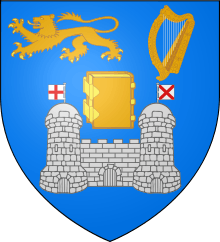
Regardless of the uncertainty over its origins, the red saltire, or saltire gules on a white field was used in the arms adopted by various Irish organisations, and some outside Ireland. The arms of Trinity College Dublin show two flags, a red cross on white and a red saltire on white, which Hayes-McCoy and Galloway interpret as representing England and Ireland respectively.[13][14] The arms were granted by Arthur Vicars in 1901, based on a 1612 seal showing uncoloured cross and saltire flags.[12] Bernard Burke's 1864 armory does not specify the flags' format,[56] and nineteenth-century depictions of them vary.[57][58]
The arms of Cork city show red-saltire flags on the two towers, though not on versions prior to 1800.[59] Coleraine Borough Council includes Saint Patrick's Saltire, as Patrick is said to have given Coleraine its name.[60] The saltire also appears in the coat of arms of the Co. Mayo town of Westport to commemorate the visit of St Patrick to the nearby mountain, Croagh Patrick.[61] It also appears on the arms of Co. Fermanagh [62] The Urban District Council of Rathmines and Rathgar was granted arms in 1929, a year before it was absorbed into Dublin Corporation; these featured a Saint Patrick's Saltire and a Celtic Cross.[63] A red saltire also appears on the arms of County Kildare, but this is because of the association of Kildare with the Fitzgerald family.

The original arms of the Royal Irish Academy in 1786 did not have the saltire, but those granted in 1846 do.[18][55] There are red saltires in the arms of the Queen's University in Ireland (est.1850, arms granted 1851; dissolved 1879) and its successor Queen's University Belfast (est.1908, arms granted 1910);[64] and the Royal College of Surgeons in Ireland.[65]
The Church of Ireland diocese of Connor's arms, granted in 1945,[66] include Saint Patrick's Saltire in memory of his supposed enslavement at Slemish.[67] The Church of England Diocese of Truro, established in 1876, has a Saint Patrick's Saltire in its arms, representing Cornwall's Celtic heritage.[68] The Roman Catholic Archdiocese of New York, whose cathedral is St Patrick's, incorporates the saltire.[69]
St Patrick's National School in Drumcondra, Dublin City has a saltire on its arms[70] St. Patrick's High School, Ottawa has the saltire in its flag and arms.[71]
To represent Ireland or Northern Ireland
.jpg)
At the 1935 celebrations in London for George V's silver jubilee, "The cross of St George representing England and Wales, and the saltires of St Andrew and St Patrick, representing Scotland and Ireland" were flown separately and used in combination.[72] At the time the Irish Free State was a separate Dominion within the British Commonwealth. In 1986, government policy during state visits to London was to fly the crosses of George, Andrew and Patrick and the Welsh Dragon.[73] The government clarified that the Union Flag was the flag of Northern Ireland, not the Saint Patrick's Saltire or the Ulster Banner.[74]
The barge Gloriana during the 2012 Thames Diamond Jubilee Pageant flew flags for the four "home nations" of the United Kingdom, including the Saint Patrick's Saltire for Northern Ireland. In this context, the symbol was referred to as St Patrick's Cross.[75]
The all-island bodies for men's and ladies' bowls compete internationally under the Saint Patrick's flag.[76][77]
The Unionist politician David McNarry has suggested the saltire should be allowed in Northern Irish number plates analogous to the flags allowed on English, Scottish, and Welsh plates.[78]
On St Patrick's Day
Saint Patrick's Flag is sometimes seen during Saint Patrick's Day parades in Northern Ireland and Britain.[46] Flags are handed out by Down District Council before the Downpatrick parade, near Patrick's burial place at Down Cathedral, in an attempt to create a parade that has cross community support.[79] This has had only limited success however, and controversy continues over the use of flags in the parade.[80] In Great Britain, Saint Patrick's Flag was flown in place of the Irish tricolour at the 2009 parade in Croydon, prompting complaints from some councillors.[81] It was flown on some years on Patrick's Day by Bradford City Council,[82] which subsequently reverted to flying the Irish tricolour.
In political movements
The Saint Patrick's Saltire was on the flag proposed in 1914 of the County Down unit of Irish Volunteers.[83] A writer in The Irish Volunteer complained that The O'Rahilly should have known the saltire was "faked for Union Jack purposes".[84]
In 1932-33 a variation of the flag with a St Patrick's blue background was adopted as the badge and flag of the short-lived Blueshirt fascist movement.[85] This militant group incorporated right-wing, conservative and some former-unionist elements in opposition to the then left-wing republican Fianna Fáil party.[86]
A flag combining St Andrew's Saltire, St Patrick's Saltire, and the Red Hand of Ulster has been used by Ulster separatists, who wish to see Northern Ireland leave the United Kingdom and become an independent state, not joining together with the Republic of Ireland.[45][87]
The saltire is incorporated in the badge of the Reform Movement,[88] a "post-nationalist" pressure group in the Republic of Ireland seeking closer ties with the United Kingdom.[89]
-

Flag of the Royal College of Surgeons in Ireland
-

Standard of Queen's University Belfast
-

Historical flag of Cumann na nGaedheal, the Blueshirts, and early Fine Gael
-
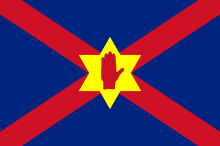
Flag proposed by the Ulster Independence Movement; also sometimes used in UDA[1]
-

Arms of the Roman Catholic Archdiocese of New York
- ^ Cite error: The named reference
cainwas invoked but never defined (see the help page).
Other symbols of Ireland
The arms of Ireland since the sixteenth century have been a gold harp with silver strings on a blue field.[90] It represented Ireland in the flags of earlier unions: the Commonwealth Flag (England and Ireland, 1649) and the Protectorate Jack (England, Ireland and Scotland, 1658). It also featured on the Royal Standard since James I.[91]
The Celtic cross and Brigid's cross are other crosses which have been used as symbols of Ireland.
Unrelated similar saltires
| Wikimedia Commons has media related to Argent a saltire gules. |
Other flags exist which feature a red saltire on a white field.
The flag of Jersey has unknown origins, and a link with St Patrick's saltire has been proposed. The FitzGerald family, who were powerful in Ireland, were Anglo-Norman in origin and also owned land in Jersey. Alternatively, N. V. L. Rybot in 1951 suggested that Jersey's flag originated from a mistake in a 1783 flag book by Carington Bowles, which was copied by later authors. Rybot's theory is that Bowles misinterpreted Ierse (Dutch for "Irish") as meaning "Jersey" in a Dutch flag-book he used as a source.[92] However, French Admiralty charts show that Jersey was using the red saltire before 1783.[93] It was widely felt in Jersey that the flag's similarity to St Patrick's Saltire was causing confusion, and so an amended flag was adopted by the States of Jersey on 12 June 1979, proclaimed by Queen Elizabeth on 10 December 1980 and first officially hoisted on 7 April 1981. The amended flag includes in the upper quadrant the badge of Jersey (a red shield holding the three leopards of Normandy in yellow) surmounted by a yellow "Plantagenet crown".
The flag of Alabama is declared to be "a crimson cross of St. Andrew on a field of white".[94] The flags of Florida and of Valdivia are derived from the Spanish Cross of Burgundy.
The village of Luqa in Malta also has a similar flag. Its origins are unknown, however the flag is almost identical to the personal flag of Grandmaster Piero de Ponte who ruled the Maltese islands from 1534 to 1535.
In the system of International maritime signal flags, a red saltire on a white background denotes the letter V and the message "I require assistance".
The arms of West Dunbartonshire derive from the former arms of the burgh of Clydebank, including a red saltire as the arms of Lennox.[95][96] Since Old Kilpatrick, a legendary birthplace of Saint Patrick, is in the district, the association of Saint Patrick's Saltire may be considered appropriate, if coincidental.[97][98][99]
-
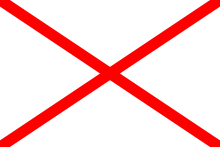
Flag of Valdivia, Chile.
See also
| Wikimedia Commons has media related to Saint Patrick's Saltire. |
- List of Irish flags
- Northern Ireland flags issue
- St. Patrick's Blue
- Flag of Alabama
References
- Hayes-McCoy, Gerard Anthony (1979). Pádraig Ó Snodaigh, ed. A history of Irish flags from earliest times. Dublin: Academy Press. ISBN 0-906187-01-X.
- Wilson, Timothy (1986). Flags at sea : a guide to the flags flown at sea by British and some foreign ships, from the 16th century to the present day, illustrated from the collections of the National Maritime Museum. London: National Maritime Museum. ISBN 0-11-290389-4.
- Groom, Nick (2007). "Union Jacks and Union Jills". In Thomas Hylland Eriksen, Richard Jenkins. Flag, Nation and Symbolism in Europe and America. Routledge. pp. 68–87. ISBN 0-415-44404-7.
Notes
- ↑ 1.0 1.1 1.2 Hayes-McCoy, p.38
- ↑ 2.0 2.1 2.2 2.3 W. G. Perrin and Herbert S. Vaughan, 1922, "British Flags. Their Early History and their Development at Sea; with an Account of the Origin of the Flag as a National Device", Cambridge University Press: Cambridge, pp. 51-52:
- ↑ Grosart, Alexander, B: The Voyage to Cadiz in 1625, Camden Society, 1883
- ↑ "HomeThe Queen and the UKQueen and Honours". Official website of the British Monarchy. Retrieved 2013-12-01.
- ↑ 5.0 5.1 5.2 5.3 Morley, Vincent (27 September 2007). "St. Patrick's Cross". Retrieved 29 June 2009.
- ↑ Oireachtas.ie website history of Leinster House
- ↑ Casey, Michael (Autumn 1991). "The Most Illustrious Order of Saint Patrick". Dublin Historical Record (Old Dublin Society) 44 (2): 6.
- ↑ http://www.flaginstitute.org/index.php?location=7
- ↑ Smith, Aquilla (1839). "On the Irish Coins of Edward the Fourth". Transactions of the Royal Irish Academy (Dublin: Royal Irish Academy) 19: 31–33.
- ↑ Hayes-McCoy, p.37
- ↑ Hayes-McCoy, pp.36–7
- ↑ 12.0 12.1 Dixon, W. Macneile (1912). "Arms of Trinity College, Dublin". Trinity College, Dublin. pp. 276–8.
- ↑ 13.0 13.1 Hayes-McCoy, pp.38–39
- ↑ 14.0 14.1 14.2 Galloway, Peter (1999). The most illustrious order : the Order of St Patrick and its knights. London: Unicorn. pp. 189–190. ISBN 0-906290-23-6.
- ↑ Daly, Peter Maurice; Alan R. Young; Leslie T. Duer; Anthony Raspa (1995). The English Emblem Tradition: Emblematic flag devices of the English civil wars, 1642-1660. Index Emblematicus 3. University of Toronto Press. p. xlvii. ISBN 0-8020-5739-X.
- ↑ Scots, Reid, Armies of the 17th century Book 3 The Royalist Armies. Partizan Press.
- ↑ True Informer news sheet, 1644
- ↑ 18.0 18.1 18.2 18.3 Hayes-McCoy, p.40
- ↑ http://historyreconsidered.net/Irish_Military_Establishment_1660_1688.html
- ↑ Flags of the World, Past and Present: Their Story and Associations. 1915. pp. 58–60.
In the first flag following that [1654] ordinance, England and Scotland were represented by the crosses of St George and St Andrew, and Ireland by a golden harp on a blue ground which is the correct standard of that country. These were displayed quarterly, St George being first and fourth, Ireland second, and St Andrew third. The standard of the Protector consisted of this flag with his escutcheon of a white lion rampant on a black field placed in the centre. The harp, however, seemed quite out of place in this flag, and another was tried in which St George was in the first and fourth, St Andrew in the second, and the red saltire on white daringly placed in the third as representing Ireland. This was a most unsatisfactory arrangement for visibility at sea, and the old Union was reverted to, but as Ireland was not shown on it, a golden harp was placed in the centre, and at the Restoration the harp was removed and the flag became as it was at the death of Charles I.
- ↑ Wilson, p.24
- ↑ Wilson, pp.28–30
- ↑ Hayes-McCoy, pp.40–41
- ↑ 24.0 24.1 Hayes-McCoy, p.41
- ↑ "London". Gazetteer and New Daily Advertiser (Gale). 26 February 1785; Issue 17 539. p. 2. Check date values in:
|date=(help); - ↑ Johnson, Richard (1740). "Of the Praise-worthy Death of St. Patrick ; how he buried himself : And for what Cause the Irishmen to this Day, do wear their Red Cross upon St. Patrick's Day.". The renowned history of the seven champions of Christendom; St. George of England, St. Denis of France, St. James of Spain, St. Anthony of Italy, St. Andrew of Scotland, St. Patrick of Ireland, and St. David of Wales. London. p. 193.
- ↑ Colgan, Nathaniel (1896). "The Shamrock in Literature: a critical chronology". Journal of the Royal Society of Antiquaries of Ireland (Royal Society of Antiquaries of Ireland) 26: 349.
- ↑ Swift, Jonathan (2008). "Letter 61". Journal to Stella. eBooks@Adelaide. University of Adelaide.
- ↑ 29.0 29.1 The popular songs of Ireland, pp.7-9 collected and ed., with intr. and notes, By Thomas Crofton Croker Published 1839
- ↑ Charles Nelson, "Shamrock", Kilkenny, 1991, pp 49-50 ISBN 0 86314 200 1
- ↑ Journal of the Royal Society of Antiquaries of Ireland Vol. 18, plate facing p.249 'Kilmalkedar'; fig.4 is "St. Patrick's Cross" [p.251] of children in S. of Irl. c.1850s
- ↑ Colgan, p.351, fn.2
- ↑ "Irishman's Diary: The Patrick's Cross". The Irish Times (ProQuest). 13 March 1935. p. 4.
- ↑ http://www.rarebooks.nd.edu/digital/heraldry/charges/crowns.html
- ↑ http://etc.usf.edu/clipart/80400/80471/80471_mitre.htm
- ↑ http://www.brothersofstpatrick.com/crest.htm
- ↑ http://catholicism.about.com/b/2012/03/17/happy-saint-patricks-day.htm
- ↑ http://catholicharboroffaithandmorals.com/St.%20Patrick.html
- ↑ http://www.maynoothcollege.ie/news/HappySaintPatricksDay2011.shtml
- ↑ http://www.stthomasaquinaschurch.org/Stained%20Glass%20Chapel%20-%20St%20Patrick.html
- ↑ http://www.catholicculture.org/culture/liturgicalyear/calendar/day.cfm?date=2012-03-17
- ↑ http://www.armagharchdiocese.org/
- ↑ http://armagh.anglican.org/
- ↑ The Flag Institute: The Union Flag Retrieved 2012-01-12
- ↑ 45.0 45.1 "Symbols in Northern Ireland - Flags Used in the Region". CAIN. University of Ulster. 6 January 2009. Retrieved 2009-07-08.
- ↑ 46.0 46.1 46.2 Groom, p.81
- ↑ 47.0 47.1 Church of Ireland General Synod Sub Committee on Sectarianism Report : April 1999 Church of Ireland
- ↑ Bryan, Dominic (2000). Orange parades: the politics of ritual, tradition, and control. Pluto Press. p. 128. ISBN 0-7453-1413-9. The St Patrick's flag is the flag of St Patrick's College, Maynooth, and is flown on Degree days and other important occasions. Its use is not affected by the creation of a separate National University of Ireland, Maynooth in 1997.
- ↑ "The RDS Flag". Royal Dublin Society. Retrieved 6 July 2009.
- ↑ "History" (PDF). Irish Girl Guides Handbook. Irish Girl Guides. January 2003. p. 2. Retrieved 2009-07-13.
- ↑ "House flag, Irish Shipping Ltd (AAA0272)". Collections Online. National Maritime Museum. Retrieved 2009-07-10.
- ↑ Rosanoski, Neale (17 June 2003). "Irish Ferries (Irish Continental Line Ltd.)". House flags of Irish shipping companies. Flags of the World. Retrieved 2009-07-10.
- ↑ Grieve, Martin; Miles Li; Jarig Bakker; Rob Raeside (19 July 2008). "Commissioner of Irish Lights". Flags of the World. Retrieved 27 April 2011.
- ↑ Dillon, Jim (1995). "The Evolution of Maritime Uniform". Beam (Commissioners of Irish Lights) 24. Retrieved 27 April 2011.
In the Lighthouse Service the cap badge originally was a St George's Cross surrounded by a wreath of laurel leaves but from 1970 the St Patrick's Cross has been used.
- ↑ 55.0 55.1 Howley, M F; John Vinycomb; G D Burtchaell (1902). "Badge of the Royal Society of Antiquaries of Ireland". Journal of the Royal Society of Antiquaries of Ireland: 415–8.
- ↑ Burke, Sir Bernard (1864). "Trinity College, Dublin". The general armory of England, Scotland, Ireland, and wales: comprising a registry of armorial bearings from the earliest to the present time. Harrison & sons. p. 1031. Retrieved 17 March 2012.
- ↑ Chessborough (15 November 1862). "Arms of Canterbury and Armagh". Notes & Queries. II (3rd Series): 392.
- ↑ Jess, J. (29 November 1862). "Arms of Canterbury, Armagh, and Trinity College, Dublin". Notes & Queries. II (3rd Series): 438–9.
- ↑ Hayes-McCoy, p.39
- ↑ "The Coat of Arms of Coleraine Borough Council". Coleraine Borough Council. Retrieved 2009-07-08.
- ↑ http://www.ngw.nl/int/ier/w/westport.htm
- ↑ http://www.civicheraldry.com/page/22081
- ↑ Jones, Laurence (2 August 2005). "Rathmines and Rathgar Urban District Council". Dublin County Council, Ireland. Flags of the World. Retrieved 2009-07-06.
- ↑ "The University's Coats of Arms". Queen's University Belfast. Retrieved 2009-07-06.
- ↑ "Stained glass: RCSI crest". Virtual tour. RCSI. Retrieved 2009-07-07.
- ↑ "How was the Diocese of Connor created?". Diocese of Connor. Retrieved 2009-07-13.
- ↑ "Nichevo" (11 May 1946). "An Irishman's Diary: Episcopal Arms". The Irish Times (ProQuest). p. 5.
- ↑ Dorling, Edward Earle (1911). Heraldry of the church: a handbook for decorators. Arts of the Church 10. London: A. R. Mowbray. p. 66.
- ↑ Sullivan, Paul J. "The Coat of Arms of His Excellency, the Most Reverend Timothy Michael Dolan, Ph.D., D.D. Archbishop of New York". Archdiocese of New York. Retrieved 2009-07-07.
- ↑ http://www.saintpats.ie/
- ↑ "St. Patrick's High School". The Public Register of Arms, Flags and Badges of Canada. Canadian Heraldic Authority. 2005. Retrieved 2009-07-06.
- ↑ HC Deb 07 May 1935 vol 301 cc814–5W
- ↑ HC Deb 22 July 1986 vol 102 c111W
- ↑ HC Deb 25 July 1986 vol 102 c571W
- ↑ Bartram, Graham (2012). "A Visual Guide to the Flags used in the Thames Diamond Jubilee Pageant". The Flag Institute. p. 5. Retrieved 7 June 2012.
- ↑ "Nolan's cross words". The Times. 5 September 2008. p. 84.
- ↑ "Full List of International Member Countries". World Bowls. Retrieved 2009-07-08.
- ↑ "St Patrick's cross 'is NI symbol'". Daily Mirror. 16 December 2008. p. 8.
- ↑ Emerson, Newton (20 March 2003). "St Patrick's parade remains inoffensive". Irish News. p. 6.
- ↑ http://www.belfasttelegraph.co.uk/news/local-national/northern-ireland/irish-language-on-st-patricks-day-parade-flag-prompts-unionist-boycott-16131547.html
- ↑ Austen, Ian (20 March 2009). "'Slap in the face to the Irish'". Croydon Advertiser. p. 19.
- ↑ "Race row over tricolour". Irish Daily Mirror. 12 April 2006. p. 27.
- ↑ Hayes-McCoy, p.200
- ↑ Hayes-McCoy, p.201
- ↑ Morris, Ewan (2005). Our own devices: national symbols and political conflict in twentieth-century Ireland. Irish Academic Press. p. 60. ISBN 0-7165-2663-8.
- ↑ Cronin, Mike (April 1995). "The Blueshirt Movement, 1932-5: Ireland's Fascists?". Journal of Contemporary History (Sage) 30 (2): 311–332. doi:10.1177/002200949503000206.
- ↑ Groom, p.85
- ↑ Johnston, Shane (Spring–Summer 2004). "The History and Origins of the Saint Patrick’s Cross" (PDF). The Reform Movement Newsletter. Reform Movement. pp. 3–4. Archived from the original on 2004-07-10. Retrieved 2009-07-06.
It is seen amongst others in the arms of Queens University, the Royal Irish Academy, The Royal College of Surgeons, and of course in the badge of the Reform Movement.
- ↑ "Aims". Reform Movement. 27 July 2007. Retrieved 2009-07-06.
- ↑ Hayes-McCoy, pp.20,22
- ↑ Hayes-McCoy, p.25
- ↑ Rybot, N. V. L. (1951). "The So-Called Jersey Flag". The Mariner’s Mirror (London: Society for Nautical Research): 82–84.
- ↑
- ↑ State Flag of Alabama Alabama Department of Archives and History
- ↑ "Clydebank District Council Coat of Arms". The Clydebank Story. West Dunbartonshire Council. Retrieved 2009-07-07.
- ↑ "West Dunbartonshire Council". Heraldry Society of Scotland. Retrieved 2009-07-07.
- ↑ Urquhart, Robert Mackenzie (1973). Scottish burgh and county heraldry. London: Gale. p. 129. ISBN 0-8103-2005-3.
- ↑ Urquhart, Robert Mackenzie (1979). Scottish Civic Heraldry: Regional, Islands, District. London: Heraldry Today. ISBN 0-900455-26-8.
- ↑ Urquhart, Robert Mackenzie (2001). Scottish civic heraldry 2. Hamilton: Scottish Library Association. ISBN 0-900649-23-2.

